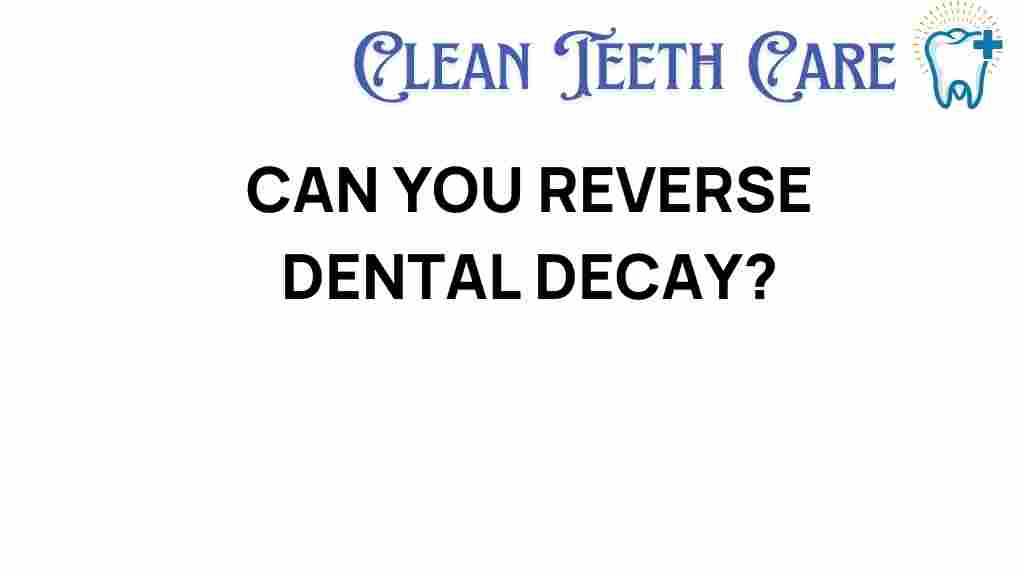Can You Really Reverse Dental Decay?
Dental decay, commonly known as cavities, is a widespread issue that affects people’s oral health across the globe. With advancements in dental care and a growing interest in holistic approaches, many individuals wonder if it’s possible to reverse dental decay. This article dives into the truth behind dental decay, prevention strategies, treatment options, and the potential for enamel regeneration. We will explore how to promote kids’ dental health and share practical tips for maintaining a healthy smile.
Understanding Dental Decay
Dental decay occurs when the hard tissues of the teeth become damaged due to the activity of bacteria. These bacteria produce acids that erode enamel, leading to cavities. Understanding the factors contributing to dental decay is crucial for prevention.
- Poor Oral Hygiene: Inadequate brushing and flossing allow plaque to build up, leading to decay.
- Diet: A diet high in sugar and carbohydrates fuels bacteria growth.
- Fluoride Deficiency: Fluoride helps remineralize enamel, and a lack of it can lead to increased decay risk.
- Dry Mouth: Saliva is essential for neutralizing acids; a dry mouth can increase decay risk.
Can Dental Decay Be Reversed?
The short answer is, yes, dental decay can be reversed at its earliest stages. When the enamel begins to demineralize, it is possible to halt and even reverse this process through specific interventions. Here’s how:
1. Enamel Regeneration
Enamel regeneration is a critical concept in dental care. When enamel is exposed to acids from food and drinks, it loses essential minerals. However, with proper care, you can encourage remineralization:
- Fluoride Treatments: Professional fluoride treatments can strengthen enamel and help reverse early decay.
- Remineralizing Toothpaste: Look for products containing calcium phosphate or fluoride to aid in remineralization.
- Dietary Changes: Eating foods rich in calcium and phosphorus can naturally remineralize teeth.
2. Prevention Strategies
Preventing dental decay is far easier than reversing it. Here are some effective prevention strategies:
- Regular Brushing and Flossing: Brush at least twice a day and floss daily to remove plaque.
- Routine Dental Check-ups: Visit your dentist every six months for cleanings and assessments.
- Healthy Diet: Minimize sugar intake and eat a balanced diet rich in fruits, vegetables, and dairy.
- Stay Hydrated: Drink plenty of water to help wash away food particles and bacteria.
Treatments for Dental Decay
If dental decay progresses beyond the initial stages, various treatment options are available:
- Fillings: For cavities that have formed, dental fillings can restore the tooth’s structure.
- Crowns: For more extensive decay, a crown may be necessary to protect the tooth.
- Root Canals: If decay reaches the tooth’s pulp, a root canal may be required to save the tooth.
- Fluoride Varnishes: Dentists can apply fluoride varnishes to help remineralize affected areas.
Holistic Approaches to Dental Health
Many individuals are exploring holistic approaches to enhance their oral health and potentially reverse dental decay. Here are some strategies:
- Oil Pulling: Swishing coconut or sesame oil in the mouth may help reduce plaque and bacteria.
- Herbal Remedies: Certain herbs, such as neem and clove, have antibacterial properties beneficial for oral health.
- Dietary Supplements: Vitamins C and D, as well as calcium, can support overall dental health.
Kids’ Dental Health: A Special Focus
Maintaining kids’ dental health is vital for their overall well-being. Here are specific tips for parents:
- Establish Good Habits Early: Teach children to brush and floss their teeth from a young age.
- Monitor Sugar Intake: Limit sugary snacks and beverages that can lead to decay.
- Regular Dental Visits: Schedule dental check-ups to catch any issues early.
- Fluoride Use: Ensure your child uses fluoride toothpaste to strengthen their enamel.
Step-by-Step Process to Reverse Early Dental Decay
If you suspect early dental decay, follow this step-by-step process:
- Assess Your Oral Hygiene: Evaluate your brushing and flossing habits. Are you doing it effectively?
- Modify Your Diet: Reduce sugar intake and incorporate more calcium-rich foods.
- Use Remineralizing Products: Invest in fluoride toothpaste and consider supplements that aid in enamel regeneration.
- Consult with a Dentist: Schedule a visit for professional advice and possible fluoride treatments.
- Implement Routine Care: Maintain a consistent oral care routine to prevent further decay.
Troubleshooting Tips for Dental Decay
If you’re struggling with dental decay, consider these troubleshooting tips:
- Evaluate Your Diet: Are you consuming too many acidic or sugary foods?
- Check for Dry Mouth: If you experience dry mouth, consult your doctor about possible remedies.
- Review Your Hygiene Routine: Ensure you’re brushing for at least two minutes and flossing daily.
- Stay Informed: Keep up with the latest research and practices in dental care.
Conclusion
In conclusion, while dental decay is a common issue, understanding how to manage and potentially reverse it can significantly enhance your oral health. Through proper prevention strategies, effective treatments, and holistic approaches, you can protect your teeth and encourage enamel regeneration. It’s essential to instill good habits in kids’ dental health early on to set the foundation for a lifetime of healthy smiles. Remember, regular dental check-ups and a proactive approach to care are your best defenses against dental decay.
For more information on maintaining oral health, visit this resource. If you’re looking for the latest advancements in dental treatments, check out this article.
This article is in the category Treatments and created by CleanTeethCare Team
